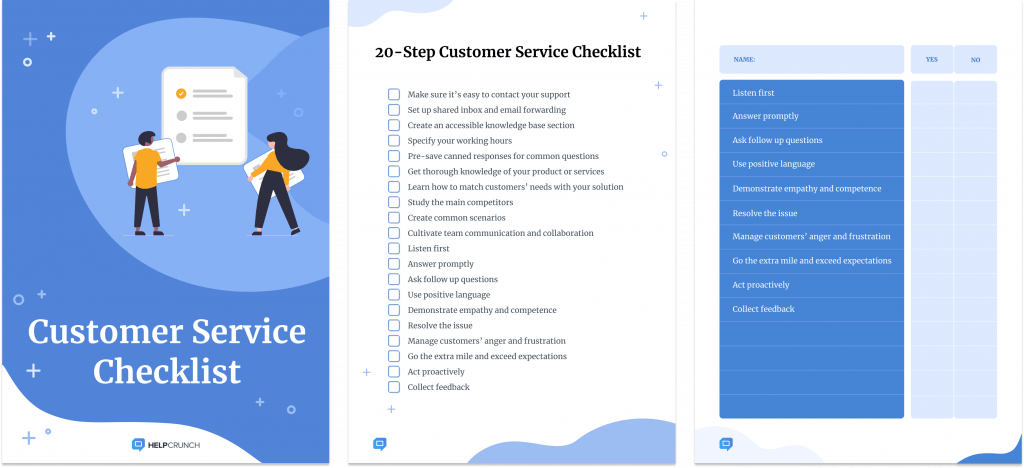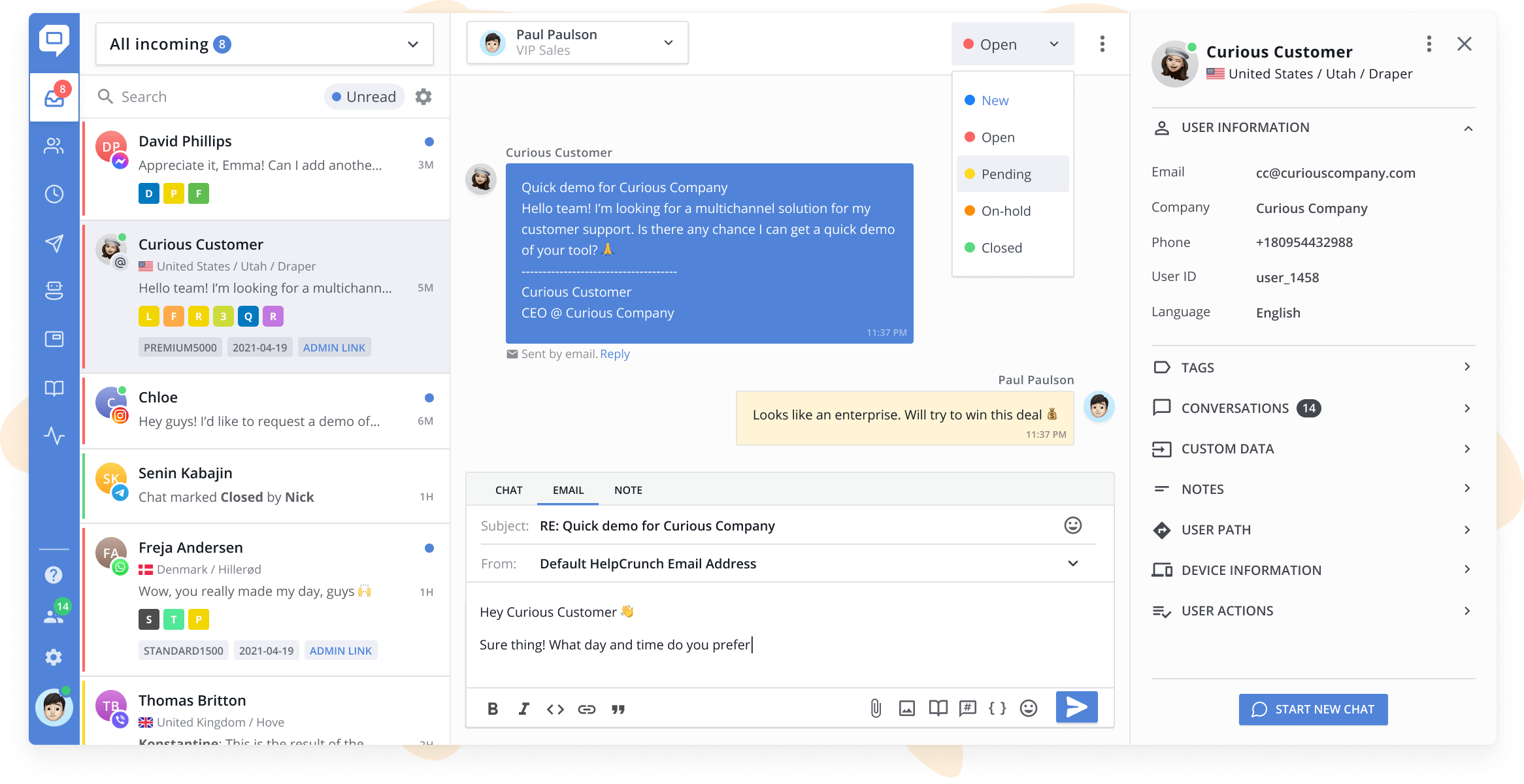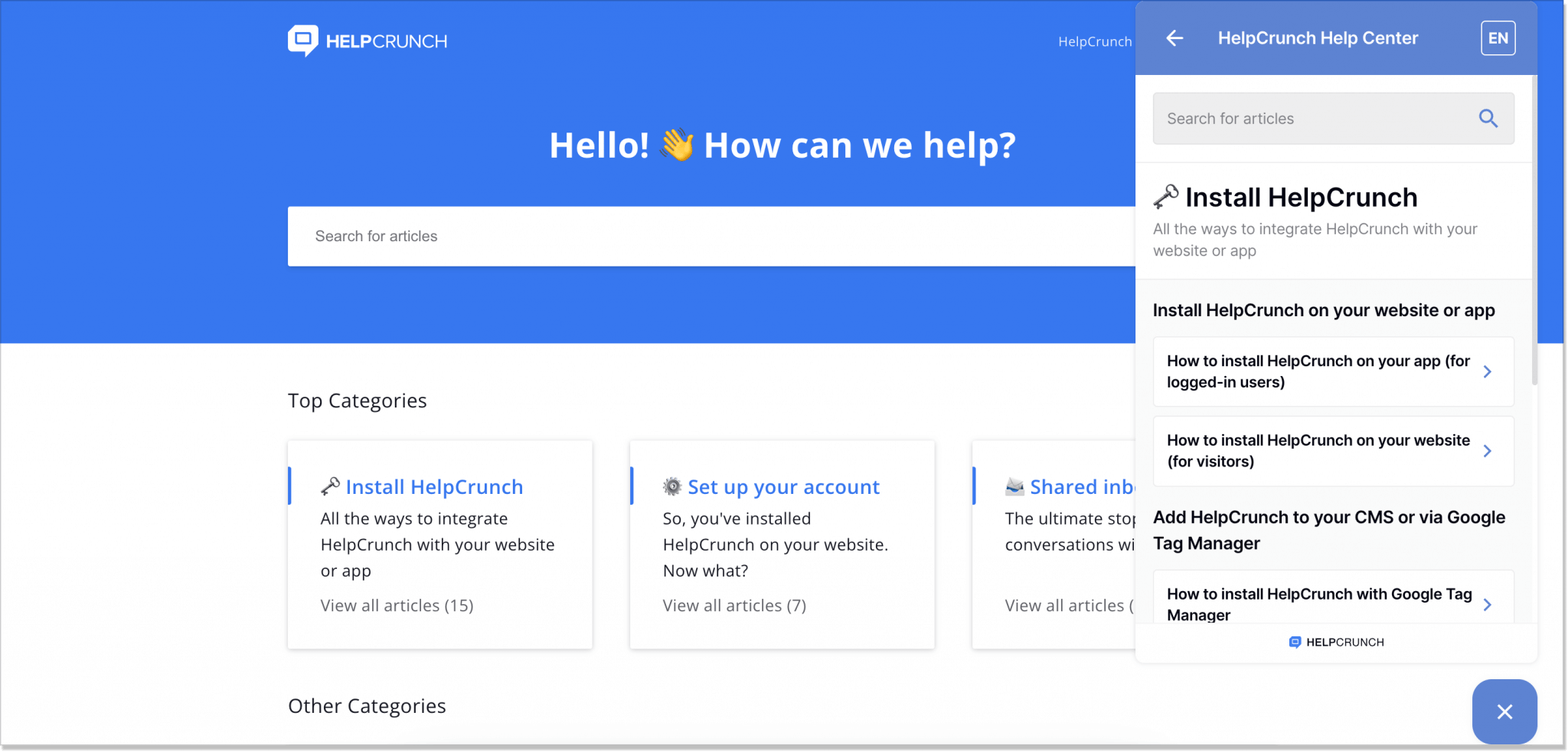The Only Customer Service Checklist You’ll Ever Need
Follow this customer service checklist template to build a flawless clock-work process. Not a single detail will slip out of sight!
Written by Anastasiia Khlystova

Checklists are awesome! I create tons of them every day in an endless pursuit of better productivity and an orderly schedule.
This love is rather unrequired, though. I rarely manage to cross off all the goals I set. And don’t get me started on the New Year’s resolution checklists — I think I’m just a few years away from decorating my bedroom wall with unused gym membership cards.
Perfection is almost unattainable. It doesn’t mean we shouldn’t try to achieve it — in life and at work, too.
The end of the year is a great opportunity to rethink your approach towards your business
in general and customer service quality assurance in particular. Set new goals, establish core customer service performance principles, and shoot for the stars!
To help you get a better perspective (and win happy customers!), we decided to share our own 20-point customer service checklist that we at HelpCrunch use to provide five-star customer service. It’s simple, but every point in it is battle-tested and 100% effective.

Download this customer service checklist PDF right away, or read on for more information on each step to better understand of the entire process.
How to use this customer service audit checklist template
First of all, this customer service checklist is a starting point for effective communication with your customers If you manage to perfect all 20 steps, congratulations! You’re a customer service prodigy whose client satisfaction rate is between 100% and thousands of 5-star reviews on Yelp.
Moreover, such a customer service checklist template will come in handy for managers and supervisors. They can use it for regular performance reviews and overall audits. Are all processes functioning properly? Maybe your team is omitting something in customer inquiries? Just follow the checklist, and you’ll know all about your team’s strengths and weaknesses.
All in all, checklists wouldn’t become so popular if it weren’t for their positive influence on efficiency and productivity. They help you bear in mind all the important details of your workflow at once. If you have a list in front of you, the chances of missing or forgetting something are close to zero.
Our 20-point customer service checklist explained
I’ve divided all 22 steps into three groups for better convenience: prepare, train, and help.
The preparatory stage includes everything concerning your customer service app and its most important settings.
If you already have a smooth-running support process, just skip it and move directly to the training part of the list. Its 5 steps will help you ensure your customer service agents are prepared for everything that can come their way.
At the bottom of this customer service audit checklist are the 10 most crucial components of effective customer communication. And I must say there’s so much more to support than just listening, analyzing, and assisting (although I must admit that those three are quite important, too.)
Now, let’s talk about each of the 20 standards for customer service checklist steps in detail:
Prepare
The first five points of this customer service checklist sample revolve around setting up your software. This includes taking care of the most popular communication channels, preparing canned responses, and creating help articles for self-service.
But let’s not get ahead of the events as we’re going to talk about them in depth now:
✅ Make sure it’s easy to contact your support
To make customers happy, start by identifying whether your support is approachable at all.
Whether it’s a live chat button, a “contact us” section, a link to social media channels, or a call center number, it should be in plain sight at all times. Like, contacting you should be ridiculously easy.
Making people wander around and linger is never a good idea for a business. If visitors can’t find a quick way to contact you to solve their customer complaints, they’ll just churn sooner or later. Run a few test drives on your website. Ask your colleagues, friends, and family members to go to your website and see how long it takes them to find a way to contact your support.
If you still haven’t decided on the preferred channels, chat software should be number one on your customer service strategy. It’s intuitive, easy to install, and allows you to provide real-time assistance. Emails and social media are close seconds.
✅ Set up shared inbox and email forwarding
Managing several customer communication channels can sound like a challenging task, but a
shared inbox makes it much easier. All requests are kept in one place, no matter the channel.
All-in-one customer support software like HelpCrunch offers live chat and allows you to set up email forwarding. This way, all messages sent to your corporate email address will end up in a simple and elegant dashboard and can be managed from there.

Customers will change communication channels in the blink of an eye. One minute, they’re chatting with you; next, they’re on X discussing your company with followers. Make sure you don’t leave a single message, social media post, or even review unanswered. Quick responses should prevail!
✅ Create an accessible knowledge base section
Self-service is an important part of every customer service process. In fact, more than half of customers nowadays prefer it to email or phone support.
However, it’s not always about email. A detailed and intuitive help center can become a remedy for their need. Build a knowledge base that answers all common issues your customers come up with all the time, and your support workload will be cut in half. Outline your business’ capacity and most frequent use cases, and your team will be out of work.

Just remember that keeping information up-to-date can be tricky. It’s a good practice to run quarterly reviews of your resource hub and update it from time to time. Thankfully, almost every modern customer service app offers a knowledge base solution. You can launch a public knowledge base website with a custom subdomain, write helpful articles, and manage them, all within one platform.
✅ Specify your working hours
When you’re in the customer service business, time is a key ingredient of success (but we’ll get to that later). Now, what do you do if 24/7 support is not something you can afford? Just specify your business hours and inform website visitors when they can expect an answer from you.
Live chat widgets can switch automatically between online and offline modes. When your team is offline, it shows a corresponding waiting message and refers everybody to your knowledge base. Autoresponders serve the same purpose for email support, while call centers use after-hour voicemail messages for it.
✅ Pre-save canned responses for common questions
As the last part of the preparatory stage of this customer service audit checklist, you should review all the most common questions and prepare short answers to them. And no, it’s not the same as a knowledge base section.
Canned responses are quick replies to common questions that you can save in your customer service tool and refer to whenever needed. Paste a pre-saved response in a couple of clicks and send it to your customers with a few personalization touches. They won’t even tell a difference, but you’ll save yourself a lot of precious time.
For starters, it’s always a good idea to prepare canned replies to the following questions:
- What does your business do?
- How are you different from your competitors?
- What pricing plans/discounts/delivery options do you offer?
- Can I have a refund?
- Are you experiencing any downtime now?
This list can go on and on, but you’ll figure it out later while interacting with real users and handling the trickiest customer queries. They’re the best source of information you can wish for.
Train
The training part of this customer service checklist template serves the purpose of preparing your support agents for every case that they will have to deal with in their work. Trained employees feel more empowered, motivated, and show higher productivity levels. So, if you want to make customers happy, start with your team.
✅ Get thorough knowledge of your product or services
If I had to choose the single most important step from the entire checklist for customer service, it would be this one. It’s just that I’m absolutely convinced a competent and knowledgeable representative will be able to help customers no matter the tools, environment, or mood.
Make sure that your customer support agents are well-versed in everything there’s to know about your business – from key features and use cases to pricing to common troubleshooting scenarios.
Providing scheduled demos and training sessions for the entire team may be one way to hone your team’s competence and win customer loyalty. Moreover, it can also be a good idea to organize meetups where different departments can exchange information and share recent news.
✅ Learn how to match customers’ needs with your solution
Customers’ needs are always at the heart of everything that businesses do. We’re not just creating products for the sake of it — we’re solving real and urgent customer concerns. That’s why thorough product knowledge should be matched with your potential customers’ goals and objectives.
You can start with short introductions into your perfect buyer personas and then tell how your business helps them. Explain all the main use cases and tell about workarounds for common pitfalls to make sure that everyone understands why you do the business in the first place.
✅ Study the main competitors and how they compare to your company
Questions about your key competitors are inevitable. With all the information available at any moment, people are free to choose from numerous options. And if your product or service doesn’t have a competitive advantage, be it an outstanding set of features or prominent support, you’re in bad luck.
The customer service team should know about your main competitors and be able to show your business’s strengths and benefits.
✅ Create common scenarios
Creating customer service scenarios for typical situations can make your support team nearly invincible. These scripts will serve as a ready-made manual anyone can refer to in difficult or questionable situations.
For instance, no one enjoys dealing with angry customers, and some even freeze when yelled at (which is hardly surprising). But if you have a step-by-step scenario with all the necessary answers and a course of action, it’s only a matter of a few clicks to handle frustration with the best possible outcome. And deliver the greatest experience for customers.
Some common scripts include feature requests, failed deliveries and refunds, downtime, and general dissatisfaction. But you’ll come up with your scenarios while interacting with customers daily.
✅ Cultivate team communication and collaboration
Even the most knowledgeable and experienced customer care representatives won’t be able to cover 100% of the issues customers face. Giving them all the necessary channels and ways to communicate with the rest of the team is an essential part of any customer service checklist template.
Create designated channels in Slack (or any team communication tool of your choice) where team members can report bugs, ask for technical assistance from developers, and share customer feedback. Sales and marketing departments should also be in close contact with customer service for continuous customer experience and knowledge exchange.
Help
After tools and training are taken care of, we’re entering the realm of vague and subjective recommendations. How do you actually provide customer service? Are there any standards that you can just follow blindly?
Well, yes! And the framework here is much stricter than you can imagine. Speed, quality, and proactive customer service aren’t just an option. They’re a must. Moreover, there are many other components in this customer service evaluation checklist that we recommend to attend to. Let’s talk about them now.
✅ Listen first
Soft skills play an important role in every customer service representative’s resume. The customer service skills checklist includes things like patience, empathy, stress management, flexibility, and persuasiveness. But active listening is where it all starts.
There can be many reasons why people contact customer support teams: to get more information before purchase, to report technical issues, or to express their frustration. The bottom line is people reach out to a customer service team to be heard in the first place. So please listen carefully first and try to get to the bottom of customers’ problems or emotions.
Let customers express themselves. Only when you get a grasp on the issue, can you craft a satisfactory reply.
✅ Answer promptly
Don’t take too long, though. Numerous research studies have already confirmed what we’ve all suspected for a long time: customers want near-immediate support.
Email support allows some room for twiddling. Over 80% of customers expect a response there within 24 hours. Live chat is stricter in this area. The commonly accepted benchmark for a first response time is less than a minute.
Consider a customer service chatbot that can deal with most of the queries on the fly. This way, you can teach it to act as quick as a fox, be shrewd (in some cases), and read the room perfectly. Trust me: all customer service expectations can be met with this small, handy machine if set up wisely.
Listening carefully shouldn’t interfere with your fast reaction. And if you can’t resolve an issue immediately, a simple acknowledgment that you’re already dealing with it will do, too.
✅ Ask follow-up questions
Some people don’t mess around and just tell you everything about their problem or inquiry in a few messages. But in most cases, you have to be a psychic to understand everything from the first letter.
Active listening means not only hearing words and registering all the information but also asking follow-up questions. And this is the only way to get to the heart of the matter.
Faced some difficulty with our website? When did you first notice? Can you describe the steps you took to get there? The more information you manage to extract, the faster the issue can be fixed.
✅ Use positive language
Positive language is all about your attitude. Nearly anything negative and frustrating can be turned into a positive with a little rephrasing.
Cognitive and mathematical psychologist Amos Tversky and 2002 Nobel Memorial Prize-winner in Economic Sciences Daniel Kahneman studied how positive wording affects peoples’ choices. In their experiment, people had to choose between two hypothetical illness treatments. But one of them was presented to people with an emphasis on positive outcomes, while the other outlined negative consequences. No wonder 72% of those surveyed chose the treatment that was positively framed while only 22% chose the option described unfavorably.
Just like with this experiment, customer service representatives can use positively framed statements to smooth things out. For instance, don’t just say, “The damage won’t be fixed for a week.” Say, “You can expect it fixed by the end of the week” instead.
✅ Demonstrate empathy and competence
Any customer service skills checklist wouldn’t be complete without empathy. Support representatives spend most of their time listening to people’s frustrations and letting them vent. It wouldn’t be possible to deal with all that without being empathetic and compassionate.
Moreover, if you’re not genuinely like that, people will feel dishonesty instantly.
So, how does one express empathy? Acknowledge the problem, show interest, and be encouraging and supportive. Have your customer service reps save a few phrases in advance:
- It sounds awful/stressful/terrible.
- We’re terribly sorry for the inconvenience.
- We’re very sorry you had to go through this.
- I want to make sure I understand…
- Is there anything else I can do for you?
- Our support team is here for you.
✅ Resolve the issue
Do we even need to discuss it? Resolving customer support tickets is the bread and butter of every customer service checklist template. You may assist via chat or email, have prepared canned responses and scenarios, and ask follow-up questions, or have no questions at all. But it all comes down to resolving every single issue and answering every question.
If you can’t deal with it momentarily and need help from other departments, convey it to customers and try to make up for the loss of time. If the ball is in your court, give the most detailed explanations and guidelines on how a person can achieve the desired outcome.
✅ Manage customers’ anger and frustration
Now, not everyone contacting customer service is angry and frustrated. Many people will be genuinely excited about your business and want to express gratitude. It’s not always bad, you know.
But when you do need to deal with angry customers, it will stick in your head. That’s why the ability to not take it personally and stay calm is very important. Otherwise, unsatisfied customers will go elsewhere to express frustration — like review websites or social media. And that’s your reputation at stake.
Come up with a system of containment that will allow you to stay friendly and helpful even in the most tricky situations. It can include everything from a simple acknowledgment and sincere apologies to extra discounts, bonuses, or free add-ons.
✅ Go the extra mile and exceed customer expectations
Cold, impersonal customer service is what we’re all accustomed to. When I contact a support agent, I don’t expect much. But there’s a slight difference between a good support agent and a brilliant one.
Humor, cultural references, and a few nice words are one way to leave a lasting impression. It’s always a good idea to throw in a joke or two when appropriate. Moreover, it’s in your power to deliver something extra, like a small thank you note or free stuff added to an order. Here is an example to ignite your inspiration:
✅ Act proactively
Reactive customer service is great, but have you tried being proactive? This customer service checklist wouldn’t be complete without a few words on the ability to anticipate customers’ needs and deliver help before someone asks for it.
I’m not saying you have to read minds. I’m just saying that the best professionals always know about all the difficulties and pitfalls your customers may face beforehand. And that’s where timely assistance comes in.
Set up a few automated proactive chat messages or non-intrusive popups on the most problematic pages of your website. They can immediately offer relevant information or suggest chatting with you for more details.
✅ Collect feedback
Customer service work doesn’t end when the ticket is closed. Every contact is a valuable source of information. So, collecting feedback must be an integral part of your daily routine. Ensure each bug report, feature request, or complaint is recorded and forwarded to corresponding departments.
It’s also a good idea to come up with a system of tags in your customer service tool. Mark each chat with a corresponding tag so that you can find them later on and follow up on each request.
The final step of this customer service checklist template would be to track support metrics.
What is your average satisfaction score? What about your first response time and resolution time? These numbers are your ultimate authority when it comes to optimization and scaling, so get the most out of the customer satisfaction surveys and the data you have at your disposal.
Final words
This customer service checklist helped us align our support processes and take them to the level that we are very proud of. Try to contact us via chat, and I am sure our highly skilled customer support staff—Konstantine, Artem, Nadiia, and Maryna—will help you quickly, accurately, and with a touch of humor.
I hope that it will help you to achieve the desired results, too. And if you need a reliable tool to implement each step on this list, sign up for a free HelpCrunch trial.





